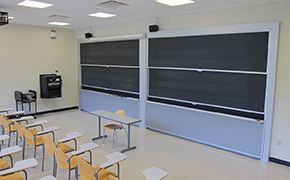Instructor Insights pages are part of the OCW Educator initiative, which seeks to enhance the value of OCW for educators.
Course Overview
This page focuses on the course 21A.506 The Anthropology of Politics: U.S. Presidential Election Edition as it was taught by Maria Vidart-Delgado in Fall 2016.
This course examined the birth and international expansion of an American industry of political marketing. It focused attention on the cultural processes, sociopolitical contexts and moral utopias that shape the practice of political marketing in the U.S. and in different countries. By looking at the debates and expert practices at the core of the business of politics, the course explored how the "universal" concept of democracy is interpreted and reworked through space and time, while examining how different cultural groups experimenting with political marketing understand the role of citizens in a democracy.
Course Outcomes
Course Goals for Students
- Identify key debates in the anthropology of politics
- Apply anthropological concepts to the analysis of politics
- Distinguish between democracy as ideal, and democracy as practice
We need more classroom discussions about uncomfortable topics. I strived to provide a safe space in which all points of view were welcome, but in which we could also openly discuss the real-world implications of our assumptions.
— Maria Vidart-Delgado
Below, Maria Vidart-Delgado responds to questions about how she taught 21A.506 The Anthropology of Politics: U.S. Presidential Election Edition.
OCW: Some educators might shy away from facilitating classroom discussions about emotionally heated topics, like elections. Tell us about your decision to create a course around this topic.
Maria Vidart-Delgado: We need more classroom discussions about uncomfortable topics. I strived to provide a safe space in which all points of view were welcome, but in which we could also openly discuss the real-world implications of our assumptions. I wrote a blogpost about this issue.
OCW: Please tell us about the mini-ethnography assignment.
Maria Vidart-Delgado: I included fieldwork in the course to give students hands-on experience with the questions and answers that one can approach through ethnography, which are very different from, for example, political science methods. Instead of asking whether elections worked or not, we were asking about particular people's relations to elections and the types of social and political bonds that elections forge. A student found out that in Reddit's “The Donald,” the conversation about white supremacy was transnational; there were eastern European participants. Another student went to a Trump rally to uncover that what bound people together wasn't Trump's political platform, but their suspicion of Hillary Clinton. Another student found out that third party candidates' online tactics are the only means available for them to build a political base, and that these online media platforms tend to be strident in tone. This student questioned the type of political bond forged in these online communities and the type of political activism that third parties promote. This assignment required supervision. I would encourage other educators to check in regularly with students to ensure that they do not get overwhelmed by the possible questions they can ask.
› Read More/Read Less
Curriculum Information
Prerequisites
None
Requirements Satisfied
HASS-H ![]()
21A.506 can be applied toward a Bachelor of Science in Anthropology, Humanities and Engineering, or Humanities and Science, but is not required.
Offered
This course was only offered in Fall 2016.
Assessment
Grade Breakdown
The students' grades were based on the following activities:
 30% Research questions and preliminary observations
30% Research questions and preliminary observations 25% Final paper
25% Final paper
 5% Presentations
5% Presentations 15% Attendance and class discussion
15% Attendance and class discussionStudent Information
Breakdown by Year
Mostly seniors
Breakdown by Major
Several students were majoring or minoring in anthropology.
Typical Student Background
All of the students were interested in politics. Some had taken anthropology classes and were interested in the anthropological approach to politics.
Ideal Class Size
The ideal class size for this discussion-based course is 8-15 students.
During an average week, students were expected to spend 12 hours on the course, roughly divided as follows:
Seminar
- Met twice a week for 1.5 hours per session; 27 sessions total; mandatory attendance.
- Class sessions were discussion-based.
Out of Class
- Outside of class, students completed readings and screenings in preparation for class sessions. They also completed two assignments and one small-scale ethnography.
Semester Breakdown
| WEEK | M | T | W | Th | F |
|---|---|---|---|---|---|
| 1 |  |  |  |  |  |
| 2 |  |  |  |  |  |
| 3 |  |  |  |  |  |
| 4 |  |  |  |  |  |
| 5 |  |  |  |  |  |
| 6 |  |  |  |  |  |
| 7 |  |  |  |  |  |
| 8 |  |  |  |  |  |
| 9 |  |  |  |  |  |
| 10 |  |  |  |  |  |
| 11 |  |  |  |  |  |
| 12 |  |  |  |  |  |
| 13 |  |  |  |  |  |
| 14 |  |  |  |  |  |
| 15 |  |  |  |  |  |
| 16 |  |  |  |  |  |
 No classes throughout MIT
No classes throughout MIT Class session
Class session Fake news exercise
Fake news exercise No class session scheduled
No class session scheduled Student presentations
Student presentations Due dates
Due dates

 Room 1 of 1
Room 1 of 1 
 25%
25%